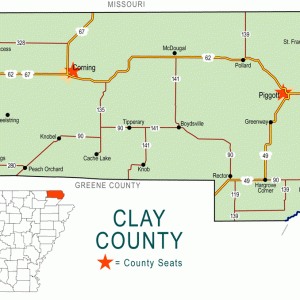calsfoundation@cals.org
Nimmons (Clay County)
| Latitude and Longitude: | 36°18’24″N 090°05’40″W |
| Elevation: | 269 feet |
| Area: | 0.25 square miles (2020 Census) |
| Population: | 69 (2020 Census) |
| Incorporation Date: | January 16, 1912 |
Historical Population as per the U.S. Census:
|
1810 |
1820 |
1830 |
1840 |
1850 |
1860 |
1870 |
1880 |
1890 |
1900 |
|
– |
– |
– |
– |
– |
– |
– |
– |
– |
– |
|
1910 |
1920 |
1930 |
1940 |
1950 |
1960 |
1970 |
1980 |
1990 |
2000 |
|
– |
297 |
193 |
217 |
199 |
154 |
135 |
112 |
96 |
100 |
|
2010 |
2020 |
|
|
|
|
|
|
|
|
|
69 |
69 |
|
|
|
|
|
|
|
|
Nimmons is a small town in eastern Clay County. It is near the St. Francis River, which forms the border between northeastern Arkansas and the bootheel of Missouri. Nimmons was created as a rail crossing and lumber town early in the twentieth century.
Prior to Euro-American settlement, the land that would become northeastern Arkansas and southeastern Missouri was dominated by swamps and hardwood forests. The area was sparsely inhabited, although the Osage and other Native American nations frequently visited the area to hunt and to fish. French explorers traveled on the St. Francis River, but the location that would become Nimmons remained uninhabited throughout the nineteenth century.
With the advent of railroads, businessmen began seeking opportunities to harvest the forests of the region. Malden Lumber Company, formed in Malden, Missouri, built a narrow gauge railroad mostly in Missouri but also in eastern Clay County in Arkansas. Called the St. Louis, Kennett and Southeastern Railroad, the line established two branches in Arkansas leading to Bear Station and to Log Yard; the settlement that grew around the branch connections was named Nimmons for a railroad worker.
The first buildings were erected in Nimmons in 1901. In 1903, the settlement was granted a post office, and it soon had two stores and a hotel. W. D. Lasswell platted the town for the lumber company, which was acquired by the Campbell Lumber Company. Campbell Lumber also was named for a Missouri bootheel town on the same rail line.
On June 28, 1907, Pole Bollock and James Mitchell, owners of the Looney Mercantile Company of Nimmons, bought out their competition, the King & Weber Store Company, which had been founded by R. T. Noland. That same day, Bollock and Mitchell approached the Campbell Lumber Company with an offer to purchase 107 acres of Arkansas land from the company, including the land on which the thirty-nine buildings in Nimmons stood. The lumber company accepted the offer, and Bollock and Mitchell became the sole owners of the houses, stores, and hotel. Lumber companies had cleared land in the Missouri bootheel by 1908, but the hardwood trees of the St. Francis River valley in Arkansas continued to provide work for lumbermen until the 1920s.
Nimmons mayor W. A. Henderson in 1923 pleaded guilty to a charge of “transporting” (apparently a violation of the Mann Act, which outlawed the interstate transportation of women or girls for sexual purposes), although additional details are not available. He paid a $400 fine and court costs. The Nimmons Mercantile Company went out of business in 1925 when owner Ed Blackburne filed for bankruptcy. By 1933, Nimmons was dependent on farming for its continued existence.
The railroad ceased service with the exhaustion of the timber supply. Country roads lead to Nimmons, but no highways pass near the town. A Baptist revival was held in Nimmons in 1915. The stores and hotel closed and were not replaced. The post office closed in 1980. In 2010 and 2020, Nimmons had sixty-nine residents, down from 100 in the 2000 census.
For additional information:
“Bought the Whole Town.” Clay County Courier, July 5, 1907, p. 1.
Webb, Robert W. History and Traditions of Clay County. Mountain Home, AR: Shiras Bros. Print Shop, 1933.
Steven Teske
Butler Center for Arkansas Studies
 Clay County Map
Clay County Map 




Love reading this. My grandpa J. W. Taylor still lives in Nimmons and tells me stories of the old days. Not much is left there.